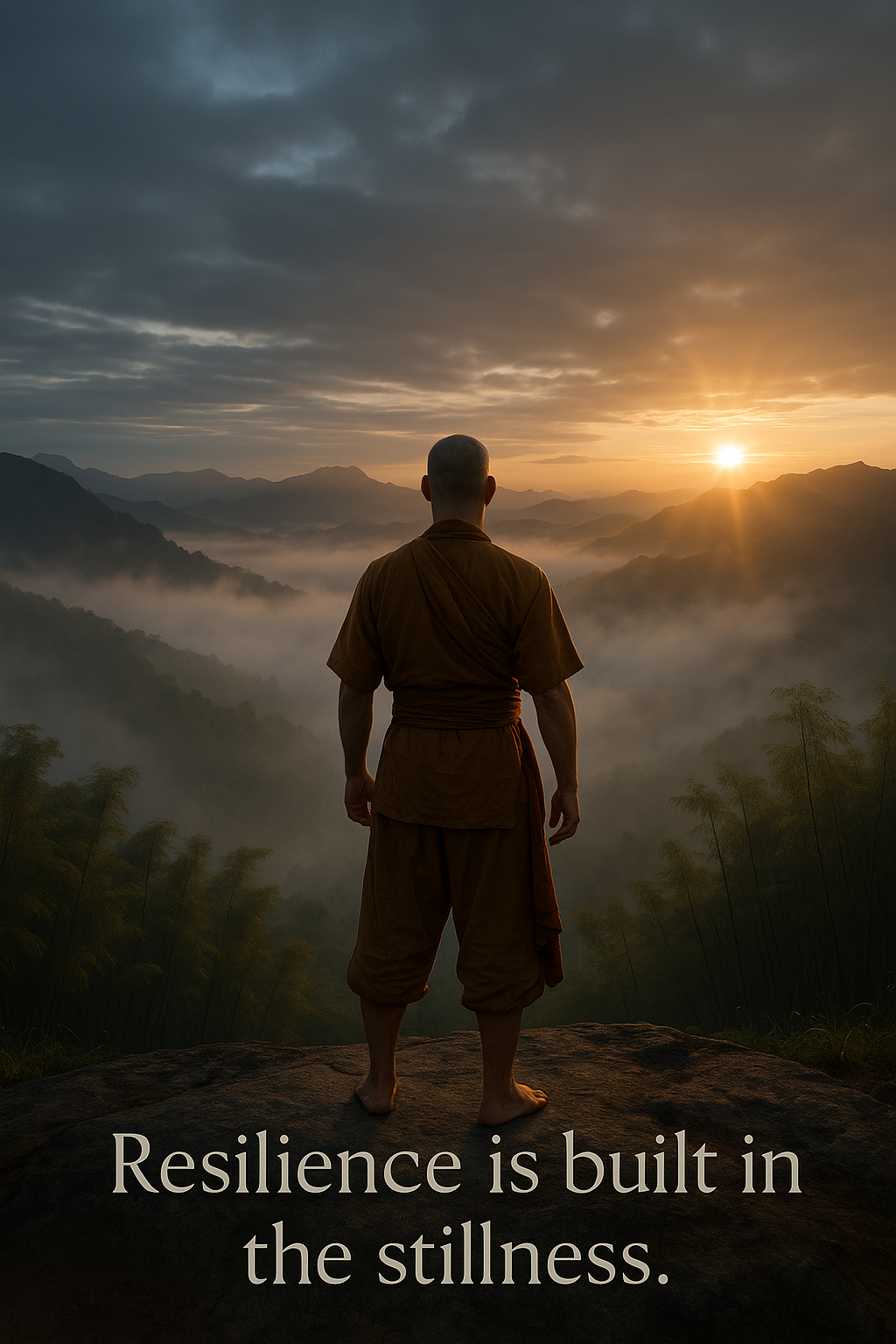How to Build Resilience: Ancient Wisdom Meets Modern Strength

Hi there! I’m Gregg Swanson, a mental strength coach and adventure enthusiast. Whether practicing Bujinkan or surviving the wilderness, I’ve learned that every challenge is an opportunity for growth.
Let’s discover how you can overcome your own obstacles and design a life of balance and fulfillment by looking at how to build resilience.
How to Build Resilience – The Hidden Power of Waiting
We live in a world obsessed with speed. One-click orders, five-second videos, and rapid-fire goal-setting have conditioned us to believe that faster equals better. But what if the true key to success…especially in mastering how to build resilience…is found not in acceleration, but in stillness?
Ancient wisdom tells a different story. Lao Tzu, the legendary Taoist sage, taught that nature never rushes, yet everything is accomplished. His philosophy wasn’t about inaction…it was about alignment. He understood that resilience isn’t brute force. It’s learning how to wait with awareness. It’s choosing flow over force.
Today, we often confuse urgency with effectiveness. But in the moments of waiting…those liminal spaces between action and outcome…we’re invited to strengthen our inner core. This is where mental toughness is forged. This is where emotional resilience takes root.
This article unpacks how to build resilience by tapping into the ancient power of patient presence. You’ll learn sustained effort techniques that don’t rely on willpower alone.
Instead, they anchor you in rhythm, discipline, and grounded clarity. If you’re ready to rewire how you approach adversity…not by charging harder, but by standing stronger…this is for you.
Let’s reclaim the sacred power of the pause.
How to Build Resilience… And What is it Really?
When most people hear “resilience,” they think of brute strength or bouncing back after setbacks. But true resilience isn’t just about gritting your teeth and powering through. It’s a refined blend of mental toughness, emotional resilience, and spiritual alignment.
Resilience is the ability to remain centered when the world shakes. It’s knowing how to hold your ground without becoming rigid, and how to flow without losing direction.
It includes the emotional resilience to feel pain without being ruled by it, and the mental toughness to keep moving without being consumed by urgency.
The problem is, hustle culture has sold us a distorted image: push harder, move faster, suffer more. But suffering without awareness is just self-destruction. The deeper truth? The most resilient leaders are not the ones who sprint the hardest…they’re the ones who master the art of strategic stillness.
This is where Taoist philosophy offers powerful insight. Lao Tzu spoke of Wu Wei…translated as “non-action” or “effortless action.” It doesn’t mean doing nothing.
It means acting in harmony with the natural order, without unnecessary force. Think of a tree bending in the wind rather than snapping. That’s resilience. That’s strength.
In today’s chaotic world, resilience means having the inner strength to pause, reflect, and choose the right action…not just the fast one. It means recognizing when to push forward and when to hold back. And most importantly, it means honoring your capacity while still moving toward growth.
So, what is resilience really? It’s the quiet power to stay steady when life tests your limits. It’s built through sustained effort techniques…not burnout, not bravado. And it’s the cornerstone of becoming unshakable in a world that never stops shaking.
Why Resilience is Built, Not Born
There’s a persistent myth that some people are just born tough…that they have an inborn grit that makes them immune to pressure. But this belief is not only false…it’s dangerous.
It convinces high performers that if they struggle, they must be weak. In reality, resilience isn’t a genetic gift. It’s a skill. And like any skill, it’s built through repetition, adversity, and reflection.
Think of the bamboo tree. For the first five years after planting, nothing seems to happen. Above the ground, there’s no visible progress. But below the surface, the bamboo is developing an intricate root system that will one day support rapid, exponential growth.
And when the time is right? It shoots up 90 feet in just six weeks. That’s resilience. That’s the power of unseen preparation.
Now consider the Taoist story of the old farmer whose horse runs away. The neighbors cry, “Such bad luck!” The farmer replies, “Maybe so, maybe not.”
The horse returns with three more horses. “Such good fortune!” Again, the farmer says, “Maybe so, maybe not.” The pattern continues…his son breaks a leg, avoids conscription, and so on. The wisdom? Don’t judge events too quickly. Stay patient. Trust the larger flow.
True resilience emerges through cycles: effort, stillness, reflection. Pushing hard, then pausing to recover. Learning from what didn’t work and refining your inner strength. It’s not built in a sprint…it’s cultivated over seasons.
This is where sustained effort techniques come in. These practices help you stay committed without burning out. They align your internal rhythms with long-term progress.
Because resilience isn’t about how hard you hit…it’s about how long you’re willing to stay in the game, aware, aligned, and unshakable.
How to Build Resilience – 5 Sustained Effort Techniques That Actually Work
1.) Practice the Pause (Mindful Response over Reaction)
Resilient leaders don’t just react…they respond. Practicing the pause means training yourself to take a breath before you act. Whether it’s a high-pressure decision or a heated conversation, this moment of mindfulness lets you shift from reactivity to clarity. Breathwork, box breathing, or counting backward from 5 are powerful tools to build this muscle. NLP tip: anchor calmness to a physical cue like touching your thumb to your forefinger.
2.) Trust the Timeline (Let Go of Urgency)
The illusion of urgency is a resilience killer. You don’t need to force what’s not ready to happen. By trusting divine timing…or the universal flow…you conserve emotional energy and build patience. Use journaling prompts like “What am I forcing?” or “Where can I surrender?” to reveal hidden tension. Warrior mindset: Power isn’t panic…it’s presence.
3.) Embrace Simplicity (Avoid Complexity Addiction)
Many high achievers equate complexity with progress. But simplicity is a power move. Cut away the nonessential. Create rituals instead of routines. Pick one priority per day and go deep. NLP-style reframing: “Doing less doesn’t mean you’re falling behind; it means you’re focused on what matters most.”
4.) Train Flexibility (Adaptability > Rigidity)
In Taoist terms, the rigid tree snaps in the wind; the flexible bamboo bends and survives. The most resilient performers know how to pivot when conditions shift. Build flexibility by exposing yourself to small doses of controlled stress…cold showers, switching up workout routines, learning a new skill. Adaptability becomes your edge.
5.) Align with Nature’s Rhythms (Flow Over Force)
Pushing past your natural rhythm leads to burnout. Instead, sync your actions with energy cycles: your own circadian rhythm, weekly productivity waves, or even lunar cycles if it resonates. Reflect in silence each morning to feel into what’s right to act on that day. Flow doesn’t mean laziness…it means optimal timing.
These sustained effort techniques aren’t hacks. They’re long-game strategies rooted in self-awareness, discipline, and spiritual attunement. Practice them consistently, and you won’t just bounce back…you’ll rise forward.
Real-World Warrior Wisdom
One of the greatest lessons I’ve ever learned about how to build resilience came during a life-or-death moment on Mt. Rainier. A sudden whiteout engulfed our team, erasing all visibility.
The wind roared like a freight train, and panic was a breath away. Every cell in my body screamed to move, to act, to do something…anything. But deep inside, I knew the truth: the mountain was in charge. Forcing movement meant risking death. So we waited.
It was the longest two hours of my life. But it taught me the kind of mental toughness that no book or podcast could deliver. That experience hardwired the understanding that sometimes, the most powerful move is no move at all. That waiting, when done with presence and trust, is not weakness…it’s wisdom.
Since then, I’ve coached dozens of high-performing clients who found themselves in less dramatic but equally uncertain territory: business plateaus, burnout cycles, relationship crossroads. T
hey wanted results now. But the ones who thrived were those who learned to “wait with wisdom.” They embraced the pause, stayed consistent with sustained effort techniques, and trusted the process.
Over time, these men didn’t just bounce back. They leveled up. Because resilience isn’t built in the rush…it’s built in the quiet between. That’s where the warrior is forged.
4 Mistakes That Destroy Resilience
1.) Mistaking Speed for Strength
In our fast-paced culture, many confuse speed with success. But moving quickly doesn’t always mean you’re moving wisely. This trap leads to burnout, sloppy decisions, and shallow wins. The NLP reframe? “Speed without strategy is just chaos in motion.” Choose depth over haste.
2.) Avoiding Discomfort Instead of Integrating It
Discomfort isn’t the enemy…it’s the doorway to growth. Yet too many high achievers numb, distract, or bypass hard emotions. True resilience requires emotional exposure and integration. Reframe discomfort as data: “This tension is showing me where my next breakthrough lives.”
3.) Rushing Decisions to Feel in Control
Making fast decisions gives the illusion of control. But when urgency drives action, wisdom gets sidelined. This creates reactive cycles that erode confidence. The NLP reframe here is: “Stillness is a strategy. Delay is not indecision; it’s intelligence.”
4.) Forcing Outcomes Instead of Aligning with Timing
Trying to force results before they’re ready leads to resistance and exhaustion. Nature doesn’t rush…yet everything gets done. Learning to align with timing allows you to conserve energy and gain leverage. Use this mindset shift: “When I stop pushing, I start progressing.”
Avoiding these four traps helps you embody how to build resilience in a grounded, sustainable way. Each reframe isn’t just a shift in thinking…it’s a new way of being. One rooted in power, patience, and presence.
Once the foundational layers of resilience are in place, it’s time to deepen the work. Advanced resilience rituals are where the warrior mindset sharpens into unbreakable steel. These practices aren’t about endurance alone…they’re about transformation.
Cold exposure is one such practice. Whether through ice baths, cold showers, or snow training, subjecting your body to controlled stress builds discipline, increases stress tolerance, and forges mental clarity. When you step into the cold and choose to stay calm, you rewire your relationship to discomfort.
Firewalking is another powerful tool…one I’ve used in my own events. Walking barefoot across burning embers is less about bravado and more about confronting the inner fire of fear. It teaches you that your limits are mostly illusions and that the body follows where the mind leads.
Stillness practices from Taoism, such as Zhan Zhuang (standing meditation) or seated breath meditation, teach you to root like a mountain and flow like water. These meditations help calm the nervous system, build emotional resilience, and reconnect you to your intuitive timing.
I recommend two classics that reinforce this inner work: The Tao Te Ching by Lao Tzu, and The Way of the Peaceful Warrior by Dan Millman. Both merge simplicity with deep power.
If you’re ready to embody these deeper practices, my private coaching programs offer guided rituals, resilience protocols, and tailored warrior training experiences. This is where mindset meets mastery. This is how to build resilience that lasts a lifetime.
Conclusion – How to Build Resilience by Learning to Wait
Resilience isn’t about how fast you bounce back. It’s about the rhythm you build between action and reflection, drive and surrender. The ancient wisdom of Taoism reminds us that true strength comes not from force, but from flow.
Nature doesn’t rush, and neither should we. If you’ve ever wondered how to build resilience without burning out, the answer lies in slowing down, aligning with your internal timing, and mastering the power of patience.
Too often, we push, force, and grind…not realizing that those efforts can actually pull us further from our goals. But when we learn to wait with awareness, we reclaim our power. Waiting isn’t weakness. It’s strategy. It’s strength. It’s where your mental toughness and emotional resilience are forged in silence.
So I ask you: Where in your life are you pushing when you should be pausing? Where are you demanding speed when the path calls for steadiness?
If you’re ready to break free from the burnout loop and build resilience that lasts…not just for the next goal, but for the long haul…then it’s time to go deeper. Book your Breakthrough Coaching Call today. Let’s craft your personal resilience playbook and reclaim the warrior within.
Q & A On How to Build Resilience
Q1: What are the best techniques for building resilience?
A: The best techniques for building resilience include practicing patience, aligning with natural timing, and mastering sustained effort through rituals like breathwork, journaling, and mindfulness. These strategies create mental and emotional strength over time.
Q2: How does waiting help build resilience?
A: Waiting develops resilience by teaching the nervous system how to regulate itself under pressure. The pause is where growth happens…internally and invisibly, just like the bamboo tree before its explosive growth.
Q3: Can resilience be learned or is it innate?
A: Resilience is absolutely learnable. It’s built through repetition, reflection, and small daily wins…not something you’re simply born with. Mindset training and warrior-based coaching accelerate this development.
Q4: Why is sustained effort better than motivation?
A: Motivation fades, but sustained effort creates results. Techniques like deliberate practice, environmental design, and mental conditioning build lasting habits that outperform short-term inspiration.
Q5: What does Taoism teach us about resilience?
A: Taoism teaches that non-resistance, flow, and timing are the true foundations of strength. By embracing simplicity and patience, we gain the flexibility and depth needed to thrive through adversity.


